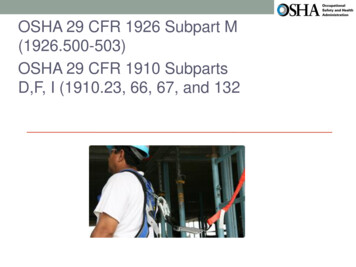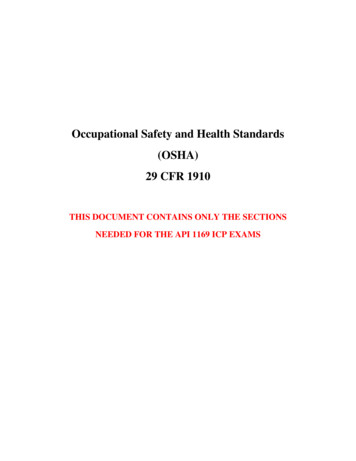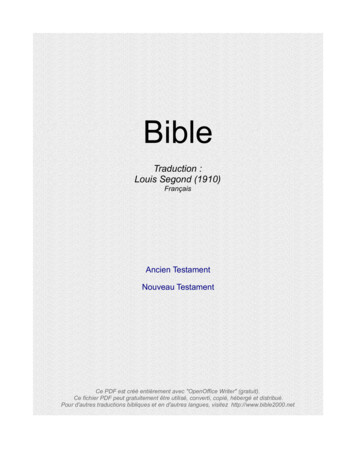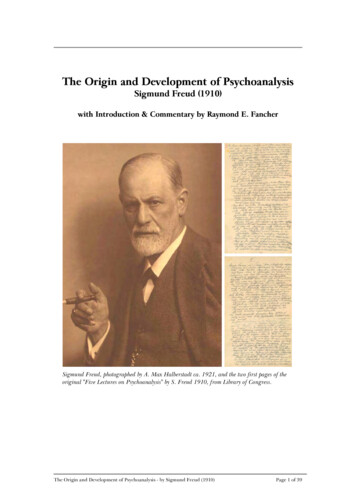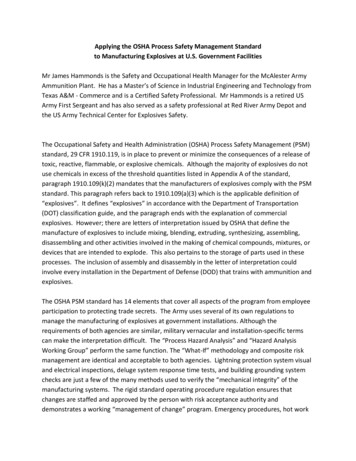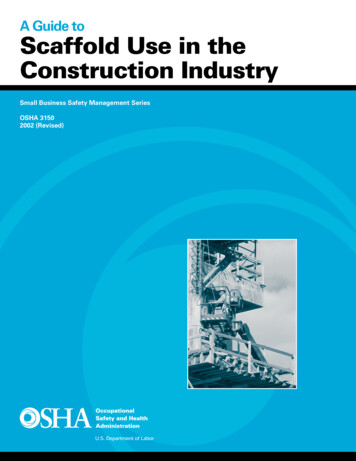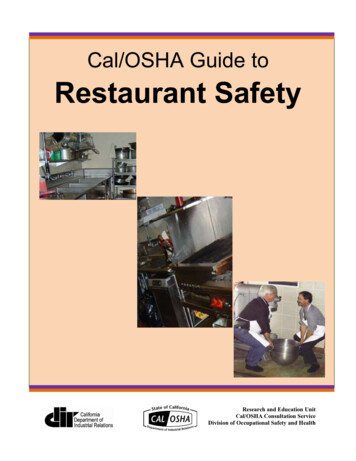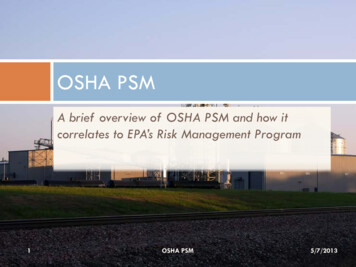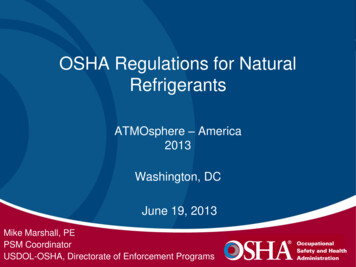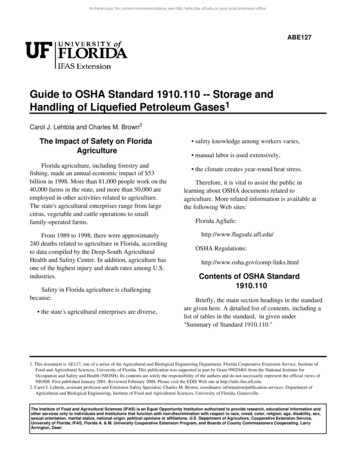
Transcription
Archival copy: for current recommendations see http://edis.ifas.ufl.edu or your local extension office.ABE127Guide to OSHA Standard 1910.110 -- Storage andHandling of Liquefied Petroleum Gases1Carol J. Lehtola and Charles M. Brown2The Impact of Safety on FloridaAgricultureFlorida agriculture, including forestry andfishing, made an annual economic impact of 53billion in 1998. More than 81,000 people work on the40,000 farms in the state, and more than 50,000 areemployed in other activities related to agriculture.The state's agricultural enterprises range from largecitrus, vegetable and cattle operations to smallfamily-operated farms.From 1989 to 1998, there were approximately240 deaths related to agriculture in Florida, accordingto data compiled by the Deep-South AgriculturalHealth and Safety Center. In addition, agriculture hasone of the highest injury and death rates among U.S.industries.Safety in Florida agriculture is challengingbecause: the state's agricultural enterprises are diverse, safety knowledge among workers varies, manual labor is used extensively, the climate creates year-round heat stress.Therefore, it is vital to assist the public inlearning about OSHA documents related toagriculture. More related information is available atthe following Web sites:Florida AgSafe:http://www.flagsafe.ufl.edu/OSHA tents of OSHA Standard1910.110Briefly, the main section headings in the standardare given here. A detailed list of contents, including alist of tables in the standard, in given under"Summary of Standard 1910.110."1. This document is AE127, one of a series of the Agricultural and Biological Engineering Department, Florida Cooperative Extension Service, Institute ofFood and Agricultural Sciences, University of Florida. This publication was supported in part by Grant 99020401 from the National Institute forOccupation and Safety and Health (NIOSH). Its contents are solely the responsibility of the authors and do not necessarily represent the official views ofNIOSH. First published January 2001. Reviewed February 2008. Please visit the EDIS Web site at http://edis.ifas.ufl.edu.2. Carol J. Lehtola, assistant professor and Extension Safety Specialist; Charles M. Brown, coordinator information/publication services; Department ofAgricultural and Biological Engineering, Institute of Food and Agricultural Sciences, University of Florida, Gainesville.The Institute of Food and Agricultural Sciences (IFAS) is an Equal Opportunity Institution authorized to provide research, educational information andother services only to individuals and institutions that function with non-discrimination with respect to race, creed, color, religion, age, disability, sex,sexual orientation, marital status, national origin, political opinions or affiliations. U.S. Department of Agriculture, Cooperative Extension Service,University of Florida, IFAS, Florida A. & M. University Cooperative Extension Program, and Boards of County Commissioners Cooperating. LarryArrington, Dean
Archival copy: for current recommendations see http://edis.ifas.ufl.edu or your local extension office.Guide to OSHA Standard 1910.110 -- Storage and Handling of Liquefied Petroleum Gases Section 1910.110(a) -- Definitionsmixtures: propane, propylene, butanes (normalbutane or iso-butane), and butylenes. Section 1910.110(b) -- Basic Rules Section 1910.110(c) -- Cylinder Systems Section 1910.110(d) -- Systems UtilizingContainers Other than DOT Containers Section 1910.110(e) -- Liquefied PetroleumGas as a Motor Fuel Section 1910.110(f) -- Storage of ContainersAwaiting Use or Resale Section 1910.110(g) -- [Reserved] Section 1910.110(h) -- Liquefied PetroleumGas Service Stations Section 1910.110(i) -- ScopeNOTE: Some sections of OSHA standards arelabeled "Reserved." This label implies either thatinformation has been deleted from the previousversion of the standard or that additions to thestandard are anticipated. Because standards oftenreference other standards, it is important thatparagraph numbers remain consistent.Where to Get OSHA Standard1910.110The standard is available through the WorldWide Web. Start at the OSHA Web site:http://www.osha.gov/or proceed directly to the Compliance area of thesite:http://www.osha.gov/comp-links.htmland click on "OSHA Regulations (Standards - 29CFR)".Summary of Standard 1910.110OSHA Standard 1910.110 is useful for anyfacility in which liquefied petroleum gases are stored.These gases, often referred to as LPG or LP-Gas,include the following, either in pure form or inThe standard specifies every aspect of storing,transferring, and transporting LP-gases. Particularconcerns of the standard are prevention of excesspressure in storage containers, safety devices,regulators, and electrical installations and otherpotential sources of ignition.The detailed list of contents below is a goodguide to the standard.1910.110(a) -- Definitions1910.110(b) -- Basic Rules(b)(1) -- Odorizing Gases(b)(2) -- Approval of Equipment and Systems(b)(3) -- Requirements for Construction andOriginal Test of Containers(b)(4) -- Welding of Containers(b)(5) -- Markings on Containers(b)(6) -- Location of Containers andRegulating Equipment(b)(7) -- Container Valves and ContainerAccessories(b)(8) -- Piping - Including Pipe, Tubing, andFittings(b)(9) -- Hose Specifications(b)(10) -- Safety Devices(b)(11) -- Vaporizer and Housing(b)(12) -- Filling Densities(b)(13) -- LP-Gas in Buildings(b)(14) -- Transfer of Liquids(b)(15) -- Tank Car or Transport TruckLoading or Unloading Points and Operations(b)(16) -- Instruction of Personnel2
Archival copy: for current recommendations see http://edis.ifas.ufl.edu or your local extension office.Guide to OSHA Standard 1910.110 -- Storage and Handling of Liquefied Petroleum Gases(b)(17) -- Electrical Equipment and OtherSources of Ignition(d)(9) -- Drips for Condensed Gas(d)(10) -- Damage from Vehicles(b)(18) -- Fixed Electrical Equipment inClassified Areas(b)(19) -- Liquid-level Gaging Device(b)(20) -- Requirements for Appliances(d)(11) -- Drains(d)(12) -- General Provisions Applicable toSystems in Industrial Plants (Of 2,000 GallonsWater Capacity and More) and to Bulk FillingPlants1910.110(c) -- Cylinder Systems(d)(13) -- Container-charging Plants(c)(1) -- Application(d)(14) -- Fire Protection(c)(2) -- Containers Shall Be Marked inAccordance with DOT Regulations(d)(15) -- [Reserved](c)(3) -- Description of a System(d)(16) -- Lighting(c)(4) -- Containers and RegulatingEquipment Installed Outside of Buildings orStructures(d)(17) -- Vaporizers for Internal CombustionEngines(c)(5) -- Containers and Equipment UsedInside of Buildings or Structures(c)(6) -- Container Valves and Accessories(d)(18) -- Gas Regulating and MixingEquipment for Internal Combustion Engines1910.110(e) -- Liquefied Petroleum Gas as aMotor Fuel(c)(7) -- Safety Devices(e)(1) -- Application(c)(8) -- Reinstallation of Containers(e)(2) -- General(c)(9) -- Permissible Product(e)(3) -- Design Pressure and Classification ofFuel Containers1910.110(d) -- Systems Utilizing ContainersOther than DOT Containers(e)(4) -- Installation of Fuel Containers(d)(1) -- Application(e)(5) -- Valves and Accessories(d)(2) -- Design Pressure and Classification ofStorage Containers(e)(6) -- Piping - Including Pipe, Tubing, andFittings(d)(3) -- Container Valves and Accessories,Filler Pipes, and Discharge Pipes(e)(7) -- Safety Devices(e)(8) -- Vaporizers(d)(4) -- Safety Devices(d)(5) -- Reinstallation of Containers(e)(9) -- Gas Regulating and MixingEquipment(d)(6) -- Capacity of Containers(e)(10) -- [Reserved](d)(7) -- Installation of Storage Containers(e)(11) -- Stationary Engines in Buildings(d)(8) -- Protection of Container Accessories(e)(12) -- Portable Engines in Buildings3
Archival copy: for current recommendations see http://edis.ifas.ufl.edu or your local extension office.Guide to OSHA Standard 1910.110 -- Storage and Handling of Liquefied Petroleum Gases(e)(13) -- Industrial Trucks Inside Buildings(e)(14) -- Garaging LP-Gas-Fueled Vehicles1910.110(f) -- Storage of Containers AwaitingUse or Resale(f)(1) -- Application(g)(14) -- Fire Extinguisher1910.110(h) -- Liquefied Petroleum GasService Stations(h)(1) -- Application(h)(2) -- Design Pressure and Classification ofStorage Containers(f)(2) -- General(f)(3) -- [Reserved](h)(3) -- Container Valves and Accessories(h)(4) -- Safety-relief Valves(f)(4) -- Storage Within Buildings NotFrequented by the Public (Such as IndustrialBuildings)(h)(5) -- Capacity of Liquid Containers(h)(6) -- Installation of Storage Containers(f)(5) -- Storage Within Special Buildings orRooms(h)(7) -- Protection of Container Fittings(f)(6) -- Storage Outside of Buildings(h)(8) -- Transport Truck Unloading Point(f)(7) -- Fire Protection(h)(9) -- Piping, Valves, and Fittings1910.110(g) -- [Reserved](g)(1) -- Application(g)(2) -- Construction and Marking ofContainers(g)(3) -- Capacity of a System(g)(4) -- Description of a System(g)(5) -- Location of Containers and Systems(g)(6) -- Container Valves and Accessories(h)(10) -- Pumps and Accessories(h)(11) -- Dispensing Devices1910.110(i) -- Scope(i)(1) -- Application(i)(2) -- Inapplicability(i)(3) -- RetroactivityTables in OSHA Standard 1910.110(g)(7) -- Safety-Relief Devices Table H-23. Recommended MinimumDistances between Water Containers(g)(8) -- System design and line pressure. Table H-24. Wall Thickness of Copper Tubing(g)(9) -- System Enclosure and Mounting Table H-25. Wall Thickness of AluminumAlloy Tubing(g)(10) -- Piping - Including Pipe, Tubing,and Fittings Minimum Required Rate of Discharge forSafety Relief Valves(g)(11) -- Appliances Air Conversion Factors(g)(12) -- General Precautions(g)(13) -- Charging of Containers Table H-26. Container and Vaporizer SafetyRelief Valves Start-to-Discharge Settings4
Archival copy: for current recommendations see http://edis.ifas.ufl.edu or your local extension office.Guide to OSHA Standard 1910.110 -- Storage and Handling of Liquefied Petroleum Gases Minimum Distances between StorageContainers and Vaporizer-Burners Table H-27. Maximum Permitted FillingDensity Table H-28. Areas in Which Open Flames AreProhibited Without Special Precautions Table H-29. Volume Correction Factors Typical Densities for Two Fuel Gases Table H-30. Relief Valve Settings Table H-31. Minimum Design Pressures forContainers Table H-32. Design Pressure for SpecificContainer Type Table H-33. Distance between an LP Tank andIts Relief Valve Table H-34. Minimum Design Pressure ofContainers Recommended Distances between Containers5
ABE127 Guide to OSHA Standard 1910.110 -- Storage and Handling of Liquefied Petroleum Gases1 Carol J. Lehtola and Charles M. Brown2 1. This document is AE127, one of a series of the Agricultural and Biological Engineering Depart
